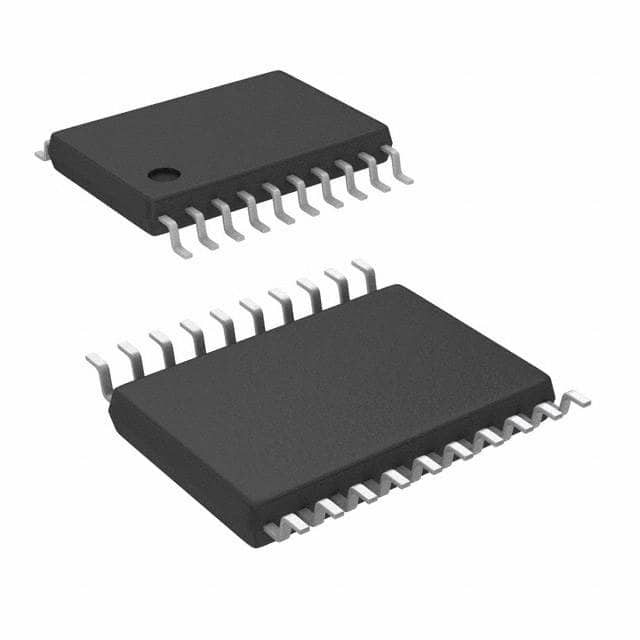Lihat spesifikasi untuk detail produk.

Encyclopedia Entry: 74ACT244TTR
Product Overview
Category
The 74ACT244TTR belongs to the category of integrated circuits (ICs) and specifically falls under the family of octal buffer/line drivers.
Use
This IC is primarily used for signal buffering and line driving applications in digital electronic systems. It provides a high-speed, non-inverting buffer with 3-state outputs, making it suitable for various digital logic designs.
Characteristics
- High-speed operation: The 74ACT244TTR offers fast propagation delays, enabling efficient data transfer.
- Non-inverting buffer: It maintains the input logic state at the output, ensuring signal integrity.
- 3-state outputs: The IC supports three output states - high impedance, logic high, and logic low - allowing multiple devices to share a common bus without interference.
- Wide operating voltage range: It can operate within a voltage range of 2V to 6V, making it compatible with different power supply levels.
- Low power consumption: The IC is designed to consume minimal power, enhancing energy efficiency.
Package and Quantity
The 74ACT244TTR is available in a small-outline transistor (SOT) package, specifically SOT-163. It is supplied in tape and reel packaging, which facilitates automated assembly processes. Typically, it is sold in quantities of 2500 units per reel.
Specifications
- Supply Voltage Range: 2V to 6V
- Input Voltage Range: 0V to VCC
- Output Voltage Range: 0V to VCC
- Operating Temperature Range: -40°C to +85°C
- Maximum Propagation Delay: 5.5 ns
- Maximum Output Current: ±24 mA
Pin Configuration
The 74ACT244TTR IC consists of 20 pins, arranged as follows:
__ __
A1 |1 `--' 20| VCC
B1 |2 19| B2
A2 |3 18| A3
B3 |4 17| B4
A4 |5 74 16| A5
B5 |6 ACT244 15| B6
A6 |7 TTR 14| A7
B7 |8 13| B8
GND |9 12| GND
OE |10 11| Y
``````````
Functional Features
- Buffering: The IC acts as a buffer, amplifying and maintaining the input signals at the output.
- Line driving: It provides sufficient current to drive signals across long distances or multiple devices.
- 3-state outputs: The 74ACT244TTR supports three output states - high impedance, logic high, and logic low - allowing for bus sharing and preventing signal conflicts.
- Noise reduction: The IC helps in reducing noise interference during signal transmission.
Advantages and Disadvantages
Advantages
- High-speed operation enables efficient data transfer.
- Non-inverting buffer maintains signal integrity.
- 3-state outputs allow for bus sharing without interference.
- Wide operating voltage range enhances compatibility.
- Low power consumption promotes energy efficiency.
Disadvantages
- Limited output current capacity may restrict certain applications requiring higher current levels.
- Sensitive to electrostatic discharge (ESD), necessitating proper handling precautions.
Working Principles
The 74ACT244TTR operates by receiving digital input signals on its input pins (A1-A7) and buffering them to the corresponding output pins (Y1-Y7). The non-inverting nature of the buffer ensures that the output state replicates the input state. The 3-state outputs enable multiple devices to share a common bus without signal conflicts.
Application Field Plans
The 74ACT244TTR finds applications in various digital systems, including but not limited to: - Microprocessor-based systems - Data communication networks - Memory interfaces - Industrial automation systems - Automotive electronics - Consumer electronics
Alternative Models
Some alternative models that offer similar functionality to the 74ACT244TTR include: - SN74ACT244N by Texas Instruments - MC74ACT244DW by ON Semiconductor - CD74ACT244E by Texas Instruments - 74ACT244SCX by Fairchild Semiconductor
These alternatives can be considered based on specific requirements and availability.
In conclusion, the 74ACT244TTR is a high-speed octal buffer/line driver IC used for signal buffering and line driving applications in digital electronic systems. Its non-inverting nature, 3-state outputs, and wide operating voltage range make it suitable for various digital logic designs. While it has advantages such as high-speed operation and low power consumption, it also has limitations in terms of output current capacity
Sebutkan 10 pertanyaan dan jawaban umum terkait penerapan 74ACT244TTR dalam solusi teknis
Sure! Here are 10 common questions and answers related to the application of 74ACT244TTR in technical solutions:
Question: What is the 74ACT244TTR?
Answer: The 74ACT244TTR is a type of octal buffer/line driver integrated circuit (IC) that can be used to amplify and buffer digital signals.Question: What is the voltage supply range for the 74ACT244TTR?
Answer: The 74ACT244TTR operates with a voltage supply range of 4.5V to 5.5V.Question: How many input/output pins does the 74ACT244TTR have?
Answer: The 74ACT244TTR has 8 input pins and 8 output pins, making it an octal buffer.Question: What is the maximum output current of the 74ACT244TTR?
Answer: The 74ACT244TTR can source or sink up to 24mA of current per output pin.Question: Can the 74ACT244TTR handle bidirectional data flow?
Answer: Yes, the 74ACT244TTR supports bidirectional data flow, allowing it to be used as a buffer for both input and output signals.Question: What is the propagation delay of the 74ACT244TTR?
Answer: The propagation delay of the 74ACT244TTR is typically around 5ns, making it suitable for high-speed applications.Question: Can the 74ACT244TTR be used in mixed-voltage systems?
Answer: No, the 74ACT244TTR is not designed for mixed-voltage systems and should only be used with a single voltage supply.Question: Is the 74ACT244TTR compatible with TTL logic levels?
Answer: Yes, the 74ACT244TTR is designed to be compatible with both TTL and CMOS logic levels.Question: Can I use multiple 74ACT244TTR ICs in parallel to increase the number of input/output pins?
Answer: Yes, you can connect multiple 74ACT244TTR ICs in parallel to expand the number of input/output pins as needed.Question: What are some common applications for the 74ACT244TTR?
Answer: The 74ACT244TTR is commonly used in digital systems for bus driving, signal buffering, level shifting, and line driving applications.
Please note that these answers are general and may vary depending on specific datasheet specifications and application requirements.

